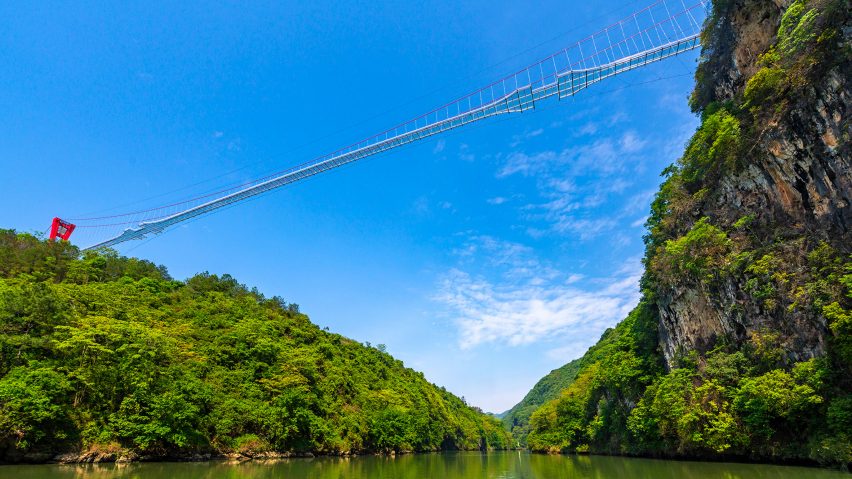After the world's longest suspension bridge was completed in Turkey last week, here is a roundup of nine impressive suspension bridges previously featured on Dezeen.
Suspension bridges are held up by vertical ties or suspension cables slung between towers, as described in the Dezeen guide to bridge design and architecture.
It's a system that allows them to span great distances and heights, with suspension bridges making up some of the world's most recognisable bridge designs.
Famous examples include the Brooklyn Bridge in New York, the Golden Gate Bridge in San Francisco and Tower Bridge in London.
Here are nine remarkable suspension bridges from around the globe:
1915 Çanakkale Bridge, Turkey (2022)
With a span of 2,023 metres, the recently completed 1915 Çanakkale Bridge traversing Turkey's European and Asian shores is the longest suspension bridge in the world. It was designed principally by consulting group COWI and is expected to carry up to 45,000 vehicles across its six lanes each day.
The bridge's distinctive red towers stand at 318 metres – higher than the Shard in London – and are claimed to be the tallest of any suspension bridge on the planet.
Find out more about 1915 Çanakkale Bridge ›
Located in the Arouca Geopark in northern Portugal, this pedestrian suspension bridge designed by Itecons is one of the longest in the world at 516 metres across.
Inverted A-shaped concrete towers at either end support two steel tensile cables, which hold up the walkway 175 metres above the Paiva river.
Find out more about 516 Arouca ›
Huangchuan Glass Bridge, China (2020)
This suspension bridge, designed by Zhejiang University's Architectural Design & Research Institute and spanning the Lianjiang River in southern China, is another record-holder.
At 526 metres, the tourist attraction has been officially recognised by Guinness World Records as the longest glass-bottomed bridge in the world. Pedestrians are able to look down through the completely clear deck to the gorge 201 metres below.
Find out more about Huangchuan Glass Bridge ›
The smallest suspension bridge on this list by far can be found at a treehouse in central Texas designed by Will Beilharz.
It reaches 18 metres across a creek from an old cypress tree where the main treehouse is nestled to a smaller bathhouse that sits on solid ground.
Find out more about Yoki Treehouse ›
Hongyagu Suspension Bridge, China (2017)
Slung above a 218-metre drop between two cliffs in the Hongyagu Scenic Area of northeastern China, this glass-bottomed suspension bridge was deliberately designed to have an unnerving sway.
It is made of 1,077 panels of four-centimetre-thick glass and supported by cables weighing more than 120 tonnes. Guards are positioned at either end of the 488-metre-long structure to help anyone struck with fear during the crossing get back to firm ground.
Find out more about the Hongyagu Suspension Bridge ›
Charles Kuonen Hängebrücke, Switzerland (2017)
Swooping 494 metres across Switzerland's deepest valley is the Charles Kuonen Hängebrücke, also known as the Europe Bridge. It connects a hiking trail between two popular ski resorts, and was at one time the longest pedestrian suspension bridge in the world.
The bridge's metal deck is just 64 centimetres wide, while mesh covers the tall angled sides to avoid obstructing views of the Alpine scenery.
Find out more about the Charles Kuonen Hängebrücke ›
Zhangjiajie Grand Canyon Glass Bridge, China (2016)
The Zhangjiajie Grand Canyon Glass Bridge, designed by Tel Aviv architect Haim Dotan, is sometimes credited with starting China's fascination with glass-bottomed bridges.
When it opened in 2016, the Zhangjiajie was the world's longest glass pedestrian bridge at 430 metres. It has since been surpassed by others on this list but remains the highest included here with a vertigo-inducing 300-metre drop to the ground.
Only two weeks after its unveiling, the bridge was forced to close temporarily due to being overwhelmed by visitors.
Find out more about Zhangjiajie Grand Canyon Glass Bridge ›
Nescio Bridge, Netherlands (2006)
London studio Wilkinson Eyre Architects designed this self-anchored curved suspension bridge in Amsterdam with help from engineering firm Arup.
The gentle slope and curve is intended to create a natural route for cyclists, but the structure forks at either end to create separate access routes for pedestrians. It is one of the very few suspension bridges in the Netherlands, where the soft ground makes anchoring cables difficult.
Find out more about the Nescio Bridge ›
Before the 1915 Çanakkale Bridge opened, the title of the world's longest suspension bridge was held by the Akashi Kaikyō, which connects the Japanese city of Kobe with Iwaya, a town on Awaji Island.
It was designed by engineer Satoshi Kashima and has a central span of 1,991 metres, with an overall length of 3,911 metres. The bridge uses more than 300,000 kilometres of steel cables to be able to withstand wind speeds of 290 kilometres per hour and earthquakes of up to 8.5 on the Richter scale.
Find out more about the Akashi Kaikyō ›
Dezeen is on WeChat!
Click here to read the Chinese version of this article on Dezeen's official WeChat account, where we publish daily architecture and design news and projects in Simplified Chinese.

